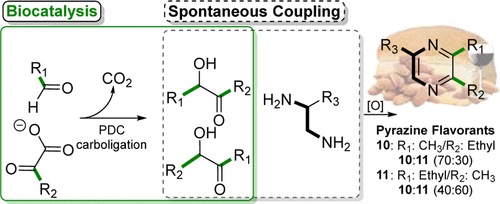当前位置:
X-MOL 学术
›
J. Agric. Food Chem.
›
论文详情
Our official English website, www.x-mol.net, welcomes your
feedback! (Note: you will need to create a separate account there.)
Semibiocatalytic Approach toward Regioisomerically Enriched Ethyl Dimethylpyrazines Important in Flavor Industries
Journal of Agricultural and Food Chemistry ( IF 5.7 ) Pub Date : 2021-12-07 , DOI: 10.1021/acs.jafc.1c05786 Gayanthi Attanayake 1 , Guohong Mao 2 , Kevin D Walker 1, 3
Journal of Agricultural and Food Chemistry ( IF 5.7 ) Pub Date : 2021-12-07 , DOI: 10.1021/acs.jafc.1c05786 Gayanthi Attanayake 1 , Guohong Mao 2 , Kevin D Walker 1, 3
Affiliation

|
Alkylpyrazines are important heterocyclic compounds used as flavorants in food and beverage industries. In this study, a regioselective semibiocatalytic process was developed to synthesize 2-ethyl-3,5-dimethylpyrazine (235-EDMP) over its 3-ethyl-2,5-dimethyl pyrazine (325-EDMP) isomer and vice versa. We initially explored how sterics could direct the coupling orientations between diamines and diketones to access 235- or 325-EDMP selectively. Also, the physical parameters of the reaction conditions were changed, such as reduced temperature, the order-of-addition of the reactants, and supplementation with chiral zeolites to template the orientation of the coupling partners to direct the reaction regiochemistry. Each reaction trial resulted in 50:50 mixtures of the EDMP isomers. An alternative approach was explored to control the regioselectivity of the reactions; α-hydroxy ketones replaced the diketones as the electrophilic coupling reactant used in previous trial experiments. The hydroxy ketone reactants were made biocatalytically with pyruvate decarboxylase. The coupling reaction between 2-hydroxypentan-3-one and propane-1,2-diamine resulted in the desired 235-EDMP at >70% (∼77 mg) relative to 325-EDMP in the mixture. The 3-hydroxypentan-2-one congener was biocatalyzed and reacted with propane-1,2-diamine as a proof of principle to synthesize 325-EDMP (∼60% relative abundance, ∼73 mg) over 235-EDMP. These results suggested a mechanism that was directed by the hydroxy ketone electrophilicity and the sterics at the diamine nucleophilic centers.
中文翻译:

区域异构富集的乙基二甲基吡嗪的半生物催化方法在香料工业中很重要
烷基吡嗪是重要的杂环化合物,用作食品和饮料行业的调味剂。在这项研究中,开发了一种区域选择性半生物催化工艺,以在其 3-乙基-2,5-二甲基吡嗪 (325-EDMP) 异构体上合成 2-乙基-3,5-二甲基吡嗪 (235-EDMP),反之亦然。我们最初探索了空间如何引导二胺和二酮之间的耦合方向以选择性地访问 235-或 325-EDMP。此外,反应条件的物理参数也发生了变化,例如降低的温度、反应物的添加顺序以及补充手性沸石以模板化偶联伙伴的取向以指导反应区域化学。每个反应试验产生 50:50 的 EDMP 异构体混合物。探索了另一种方法来控制反应的区域选择性;α-羟基酮取代了二酮作为之前试验实验中使用的亲电偶联反应物。羟基酮反应物是用丙酮酸脱羧酶生物催化制备的。2-羟基戊烷-3-酮和丙烷-1,2-二胺之间的偶联反应产生了所需的 235-EDMP,相对于混合物中的 325-EDMP,>70%(约 77mg)。3-羟基戊烷-2-one 同源物被生物催化并与丙烷-1,2-二胺反应,作为合成 325-EDMP(~60% 相对丰度,~73 mg)超过 235-EDMP 的原理证明。这些结果表明了一种由羟基酮亲电性和二胺亲核中心的空间位阻所指导的机制。α-羟基酮取代了二酮作为之前试验实验中使用的亲电偶联反应物。羟基酮反应物是用丙酮酸脱羧酶生物催化制备的。2-羟基戊烷-3-酮和丙烷-1,2-二胺之间的偶联反应产生了所需的 235-EDMP,相对于混合物中的 325-EDMP,>70%(约 77mg)。3-羟基戊烷-2-one 同源物被生物催化并与丙烷-1,2-二胺反应,作为合成 325-EDMP(~60% 相对丰度,~73 mg)超过 235-EDMP 的原理证明。这些结果表明了一种由羟基酮亲电性和二胺亲核中心的空间位阻所指导的机制。α-羟基酮取代了二酮作为之前试验实验中使用的亲电偶联反应物。羟基酮反应物是用丙酮酸脱羧酶生物催化制备的。2-羟基戊烷-3-酮和丙烷-1,2-二胺之间的偶联反应产生了所需的 235-EDMP,相对于混合物中的 325-EDMP,>70%(约 77mg)。3-羟基戊烷-2-one 同源物被生物催化并与丙烷-1,2-二胺反应,作为合成 325-EDMP(~60% 相对丰度,~73 mg)超过 235-EDMP 的原理证明。这些结果表明了一种由羟基酮亲电性和二胺亲核中心的空间位阻所指导的机制。2-羟基戊烷-3-酮和丙烷-1,2-二胺之间的偶联反应产生了所需的 235-EDMP,相对于混合物中的 325-EDMP,>70%(约 77mg)。3-羟基戊烷-2-one 同源物被生物催化并与丙烷-1,2-二胺反应,作为合成 325-EDMP(~60% 相对丰度,~73 mg)超过 235-EDMP 的原理证明。这些结果表明了一种由羟基酮亲电性和二胺亲核中心的空间位阻所指导的机制。2-羟基戊烷-3-酮和丙烷-1,2-二胺之间的偶联反应产生了所需的 235-EDMP,相对于混合物中的 325-EDMP,>70%(约 77mg)。3-羟基戊烷-2-one 同源物被生物催化并与丙烷-1,2-二胺反应,作为合成 325-EDMP(~60% 相对丰度,~73 mg)超过 235-EDMP 的原理证明。这些结果表明了一种由羟基酮亲电性和二胺亲核中心的空间位阻所指导的机制。
更新日期:2021-12-22
中文翻译:

区域异构富集的乙基二甲基吡嗪的半生物催化方法在香料工业中很重要
烷基吡嗪是重要的杂环化合物,用作食品和饮料行业的调味剂。在这项研究中,开发了一种区域选择性半生物催化工艺,以在其 3-乙基-2,5-二甲基吡嗪 (325-EDMP) 异构体上合成 2-乙基-3,5-二甲基吡嗪 (235-EDMP),反之亦然。我们最初探索了空间如何引导二胺和二酮之间的耦合方向以选择性地访问 235-或 325-EDMP。此外,反应条件的物理参数也发生了变化,例如降低的温度、反应物的添加顺序以及补充手性沸石以模板化偶联伙伴的取向以指导反应区域化学。每个反应试验产生 50:50 的 EDMP 异构体混合物。探索了另一种方法来控制反应的区域选择性;α-羟基酮取代了二酮作为之前试验实验中使用的亲电偶联反应物。羟基酮反应物是用丙酮酸脱羧酶生物催化制备的。2-羟基戊烷-3-酮和丙烷-1,2-二胺之间的偶联反应产生了所需的 235-EDMP,相对于混合物中的 325-EDMP,>70%(约 77mg)。3-羟基戊烷-2-one 同源物被生物催化并与丙烷-1,2-二胺反应,作为合成 325-EDMP(~60% 相对丰度,~73 mg)超过 235-EDMP 的原理证明。这些结果表明了一种由羟基酮亲电性和二胺亲核中心的空间位阻所指导的机制。α-羟基酮取代了二酮作为之前试验实验中使用的亲电偶联反应物。羟基酮反应物是用丙酮酸脱羧酶生物催化制备的。2-羟基戊烷-3-酮和丙烷-1,2-二胺之间的偶联反应产生了所需的 235-EDMP,相对于混合物中的 325-EDMP,>70%(约 77mg)。3-羟基戊烷-2-one 同源物被生物催化并与丙烷-1,2-二胺反应,作为合成 325-EDMP(~60% 相对丰度,~73 mg)超过 235-EDMP 的原理证明。这些结果表明了一种由羟基酮亲电性和二胺亲核中心的空间位阻所指导的机制。α-羟基酮取代了二酮作为之前试验实验中使用的亲电偶联反应物。羟基酮反应物是用丙酮酸脱羧酶生物催化制备的。2-羟基戊烷-3-酮和丙烷-1,2-二胺之间的偶联反应产生了所需的 235-EDMP,相对于混合物中的 325-EDMP,>70%(约 77mg)。3-羟基戊烷-2-one 同源物被生物催化并与丙烷-1,2-二胺反应,作为合成 325-EDMP(~60% 相对丰度,~73 mg)超过 235-EDMP 的原理证明。这些结果表明了一种由羟基酮亲电性和二胺亲核中心的空间位阻所指导的机制。2-羟基戊烷-3-酮和丙烷-1,2-二胺之间的偶联反应产生了所需的 235-EDMP,相对于混合物中的 325-EDMP,>70%(约 77mg)。3-羟基戊烷-2-one 同源物被生物催化并与丙烷-1,2-二胺反应,作为合成 325-EDMP(~60% 相对丰度,~73 mg)超过 235-EDMP 的原理证明。这些结果表明了一种由羟基酮亲电性和二胺亲核中心的空间位阻所指导的机制。2-羟基戊烷-3-酮和丙烷-1,2-二胺之间的偶联反应产生了所需的 235-EDMP,相对于混合物中的 325-EDMP,>70%(约 77mg)。3-羟基戊烷-2-one 同源物被生物催化并与丙烷-1,2-二胺反应,作为合成 325-EDMP(~60% 相对丰度,~73 mg)超过 235-EDMP 的原理证明。这些结果表明了一种由羟基酮亲电性和二胺亲核中心的空间位阻所指导的机制。











































 京公网安备 11010802027423号
京公网安备 11010802027423号